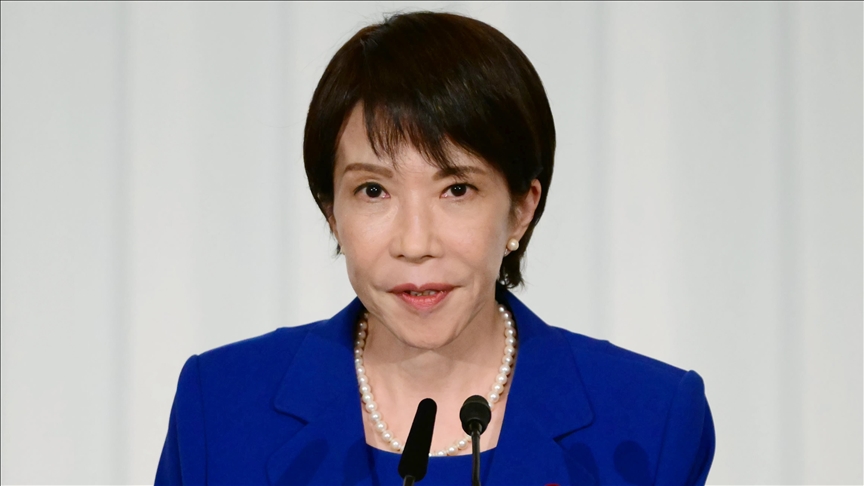PROFILE - Sanae Takaichi, Japan’s 1st female premier, takes helm with focus on economy, security
Liberal Democratic Party’s conservative chair Sanae Takaichi becomes country's 1st female prime minister

Liberal Democratic Party’s conservative chair Sanae Takaichi becomes country's 1st female prime minister
Economy, defense 2 key areas under focus as 64-year-old politician takes helm
Coalition of LDP and Japan Innovation Party ‘increases likelihood that Japan will pursue more proactive foreign and security policies than before,’ academic Kazuto Suzuki tells Anadolu
ISTANBUL
The lawmakers of Japan's bicameral parliament on Tuesday elected the country’s first female prime minister, Sanae Takaichi, the ruling Liberal Democratic Party’s (LDP) newly elected conservative chair.
The 64-year-old hawkish politician secured 237 and 125 votes in the lower and upper chambers of the bicameral parliament, respectively, clearing her path to become the 104th prime minister in the post-war era of Japan.
Earlier this month, Takaichi was elected the LDP’s first female chair but soon faced a setback when the party’s long-time ally Komeito upended the government coalition.
However, she quickly worked through other parties and secured the support of the right-wing Japan Innovation Party (JIP), whose 35 lawmakers proved crucial in electing Takaichi as the premier.
Born on March 7, 1961, in Yamatokoriyama City in Nara province, located in the western part of Honshu, Japan’s main island, Takaichi studied at the country's Kobe University.
After graduation, she worked as an author, legislative aide, and broadcaster before entering politics. She was first elected to the House of Representatives in the 1993 general election as an independent, later joining the LDP. Since then, she has been reelected to the House nine times.
The JIP will not join Takaichi’s Cabinet but will extend outside support to the government on an issue-by-issue basis. It has put up at least 12 demands for the coalition to continue.
Of the three minimum requirements, the JIP wants the coalition to reduce the number of parliamentary seats by 10%, a proposal to make Osaka Japan’s secondary capital, besides implementing social security reform.
While the new allies have not said anything about snap polls, the general elections are due by October 2027 – effectively giving Takaichi two years to command the world’s fourth-largest economy.
A close aide of late Prime Minister Shinzo Abe, she is the fifth prime minister of Japan in as many years as the country saw the ruling LDP face a political funds scandal, as well as ties of its lawmakers to the controversial Unification Church which eroded its support base.
Soon after securing victory for Takaichi, LDP senior officials said beating inflation and strengthening the economy would be a priority.
Takaichi is known for her hawkish views on China, Koreas, and Japan’s wartime history.
Focus on defense, economy
Takaichi’s immediate focus would be the economy, as well as boosting the defense of the country, which has a "pacifist" constitution.
Kazuto Suzuki, a political scientist and professor at the University of Tokyo, told Anadolu that younger generations in Japan “have fading or no memories” of World War II and their perspective “is very different.”
“Many feel threatened by China's military rise and North Korea's missiles. Events like Russia's invasion of Ukraine and the reelection of President Donald Trump in the US have eroded their trust in the international order based on the rule of law,” he said.
“More voters believe Japan should strengthen its national capabilities, including its military, or risk being dominated by foreign powers. Domestically, migration is an increasingly important issue, fueling discontent and feeding support for right-wing parties,” said the Japanese academic.
Takaichi is already planning to strengthen Japan’s deterrence by increasing the country’s defense spending from 1% to 2% of gross domestic product (GDP).
She also wants to amend Article 9 of the Constitution, which prohibits Japan from maintaining a war-fighting force, in a bid to strengthen the military.
The new prime minister “is described as a hawk on security issues and has previously visited the Yasukuni Shrine, which honors Japanese war dead,” said Suzuki, recalling that Abe visited the shrine in 2013, angering China and South Korea.
He added that Komeito, the former ally of the LDP, had “historically appealed to pacifist, liberal-minded supporters, presenting itself as a check” on the security policies of Takaichi’s party.
Takaichi has justified her visits to the war shrine, saying war criminals deserve condolences due to being executed, while South Korea and China think otherwise, having suffered from Japan’s history of occupation.
She stayed away from visiting the shrine this autumn, sending “offerings” to the controversial wartime temple, but drew opposition from Beijing.
The LDP chair has ruled out visiting the controversial shrine as prime minister, according to Suzuki.
“The concern (for Komeito) was likely that under Takaichi, this restraint would cease to function.”
Weakened LDP and ‘surging right’
Suzuki said Takaichi claims herself “as the successor to former Prime Minister Shinzo Abe and his assertive Japanese foreign policy, which built new security partnerships, boosted defense spending, and expanded the remit of the country’s Self Defense Forces.”
Abe was assassinated in 2022 in Takaichi’s hometown of Nara.
“But Takaichi’s ability to replicate Abe’s success is uncertain, as she leads a weakened” LDP, confronts a “surging far right at home, and negotiates relations with an unpredictable US partner,” Suzuki said.
Meanwhile, Yoshihiko Noda, the leader of the main opposition Constitutional Democratic Party of Japan, has expressed concern about a potential shift to right-wing, as the LDP and JIP sealed a coalition deal.
“In order to regain the support of the traditional conservative base, the LDP may pursue a more right-leaning course,” Suzuki also warned.
The LDP has over the years seen its support base shrinking, with only 196 lawmakers, leaving it at the mercy of allies.
Japan, the world’s fourth-largest economy, is also facing 15% tariffs from the US amid a sluggish economy.
However, Takaichi has drawn praise from US President Donald Trump after she won the LDP election.
She may soon welcome Trump as her first guest as the US president embarks on an Asia tour later this week.
“Many of Sanae Takaichi's proposals for Japan to become a ‘normal nation’ – such as amending the constitution and establishing a national defense force – resemble those of Shinzo Abe,” Chien-Yu Shih, associate research fellow at the Taipei-based Institute for National Defense and Security Research, told Anadolu.
“However, Japan's economy faces both US tariff trade wars and pressure from China. This makes it extremely difficult to put her political agenda into practice,” said Shih, agreeing with Japanese academic Suzuki.
Takaichi has pledged to rework the tariffs deal with the Trump administration.
The coalition of the LDP and the JIP “increases the likelihood that Japan will pursue more proactive foreign and security policies than before,” Suzuki also noted.
'Partner to stay out of spotlight'
Takaichi’s husband, Taku Yamamoto, said he hopes to support his wife as a "stealth husband," and that "unlike in the West, it is better for the partner to stay out of the spotlight here."
The former LDP member in the House of Representatives, described his wife as "a person who studies harder than anyone, with her room filled with books and documents."
Takaichi adopted Yamamoto's three children from his previous marriage.
Yamamoto, who is considered dovish in politics, was seen standing eye-to-eye with his wife during the 2012 LDP presidential race, when the former LDP lawmaker supported former Prime Minister Shigeru Ishiba, while the first female prime minister backed the late Abe, who won the election and returned to power.
The couple married in 2004 but divorced in 2017, attributing that decision to "differences in political views.
The couple remarried in 2021.
*Berk Kutay Gokmen contributed to the story








